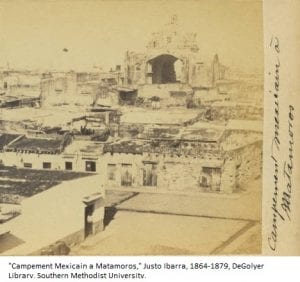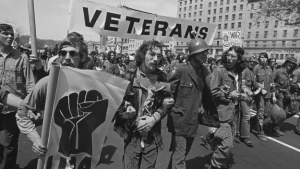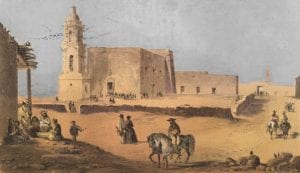In Professor Ariel Ron’s Graduate Colloquium,
U.S. History, 1812-1877, I wrote a historiographical paper on the early development of agriculture in California. Since I wanted to broaden my understanding of U.S. agriculture, I knew that I wanted to continue to research themes that related to agriculture in forthcoming courses. Thus, I met with Professor Crista DeLuzio on a September evening to discuss my intentions for her fall colloquium on U.S. History from 1877-1929. In her office, we discussed my research interests, which helped me choose a topic for my historiographical assignment. During our conversation, I realized that I wanted to study women’s role in agricultural labor during the decades surrounding the twentieth century. I presented my idea to Professor DeLuzio and she approved my topic. As the semester progressed, I found only a handful of books and articles that addressed the subject in depth. Historians, of this field, raised questions about women’s role in agriculture. For example, what was the role of African American women in agriculture? How did women affect family farms? How did women’s labor differ throughout the United States? How did women perform agricultural labor alongside their husbands and sons? Ultimately, I was surprised to find that there are few works that discusses women’s role in agricultural labor from 1870-1920.

Marion Barthelme’s Women in the Texas Populist Movement: Letters to the Southern Mercuryreveals the speeches, essays, and letters women wrote to the influential Southern Mercury. The Farmers’ Alliance recognized the Southern Mercury’s significance in advancing policies of the Populist Movement. In her work, Bartheleme publishes the original documents, so readers can understand how women felt about everyday experiences. Women wrote letters that discussed themes such as: politics, farm life, women’s suffrage, education, clothing, temperance, as well as other matters. Through government advancements of the nuclear family, women were often characterized as individuals who focused on the nurture of their households. However, Texan women worked outside of their homes by helping men in fields and pastures. Women collected goods in gardens and pastures to exchange them for necessary commodities. During periods of economic downturns, however, women continued to financially struggle. While they kept on working in and outside of the home, their work did not bring them the financial security they needed. Thus, through Barthelme’s work, I was able to observe one trend of women in agricultural labor.[i]
From Mary Neth’s Preserving the Family Farm: Women, Community, and the Foundations of Agribusiness in the Midwest, 1900-1940, I learned about women’s agricultural labor in a different region.  Neth acknowledges the gender inequalities that existed even in most cooperative family farms; however, men, women, and children cast aside such inequalities to preserve their farms as agribusiness grew in the Midwest. While historians have characterized such instances as opportunities for women’s resistance, Neth argues that Midwestern women put their families before themselves. By participating in field labor and family care, women created commodities such as poultry flocks and eggs for their families as well as the market. Also, young boys and girls dug and planted potatoes, picked berries, and set tobacco. Families utilized these subsistence mechanisms to stabilize their household budgets, so they would not be bought off by agribusiness agents. Neth describes how certain commodities required women’s labor. For example, in Wisconsin, mothers and daughters gathered tobacco. Since farmers could not afford to employ many laborers, all family members often worked together in tobacco fields. Thus, families kept some of their purchasing power by not hiring additional labor. Women’s work in pastures and field was clear. In times of government surveys of agricultural production, however, women reported that they only helped in production. Therefore, women’s full participation in agricultural production was unintentionally overlooked.[ii]
Neth acknowledges the gender inequalities that existed even in most cooperative family farms; however, men, women, and children cast aside such inequalities to preserve their farms as agribusiness grew in the Midwest. While historians have characterized such instances as opportunities for women’s resistance, Neth argues that Midwestern women put their families before themselves. By participating in field labor and family care, women created commodities such as poultry flocks and eggs for their families as well as the market. Also, young boys and girls dug and planted potatoes, picked berries, and set tobacco. Families utilized these subsistence mechanisms to stabilize their household budgets, so they would not be bought off by agribusiness agents. Neth describes how certain commodities required women’s labor. For example, in Wisconsin, mothers and daughters gathered tobacco. Since farmers could not afford to employ many laborers, all family members often worked together in tobacco fields. Thus, families kept some of their purchasing power by not hiring additional labor. Women’s work in pastures and field was clear. In times of government surveys of agricultural production, however, women reported that they only helped in production. Therefore, women’s full participation in agricultural production was unintentionally overlooked.[ii]
 By the turn of the twentieth century, women’s role in agricultural labor significantly increased during World War I. Cecilia Gowdy Wygant’s Cultivating Victory: The Woman’s Land Army and the Victory Garden Movement examines British and American women’s role in agricultural labor during both World Wars. Wygant argues that between 1900 and 1950 both British and American governments utilized images of agrarian women as symbols of nationalism which questioned their roles in farming and gardening. Once the U.S. joined the Allies in World War I, the federal government created the Women’s Land Army of America (WLAA). The WLAA trained women, so they could serve as agricultural workers. Women’s groups and college campuses created agricultural training programs for women with the WLAA’s help. For example, the University of Virginia taught women how to plow, harrow, till land, and prepare land by horse-drawn plows. Women who completed the training were known as “farmerettes.” Through such endeavors, women contributed to the war effort by producing food for their respective nations. More importantly, women’s strong participation in agricultural labor reinterpreted women’s role in agriculture as well as society. For example, the WLAA recommended better labor standards for agricultural laborers. They advocated for better cleanliness in living quarters to protect workers and the food supply. Also, the group called for improved boarding, compensation, and working conditions when they were employed. Women used these organizations to change some of the unfair practices in agriculture. While they were not always successful, their activism altered perceptions of normal agricultural practices such as conditions of living quarters.
By the turn of the twentieth century, women’s role in agricultural labor significantly increased during World War I. Cecilia Gowdy Wygant’s Cultivating Victory: The Woman’s Land Army and the Victory Garden Movement examines British and American women’s role in agricultural labor during both World Wars. Wygant argues that between 1900 and 1950 both British and American governments utilized images of agrarian women as symbols of nationalism which questioned their roles in farming and gardening. Once the U.S. joined the Allies in World War I, the federal government created the Women’s Land Army of America (WLAA). The WLAA trained women, so they could serve as agricultural workers. Women’s groups and college campuses created agricultural training programs for women with the WLAA’s help. For example, the University of Virginia taught women how to plow, harrow, till land, and prepare land by horse-drawn plows. Women who completed the training were known as “farmerettes.” Through such endeavors, women contributed to the war effort by producing food for their respective nations. More importantly, women’s strong participation in agricultural labor reinterpreted women’s role in agriculture as well as society. For example, the WLAA recommended better labor standards for agricultural laborers. They advocated for better cleanliness in living quarters to protect workers and the food supply. Also, the group called for improved boarding, compensation, and working conditions when they were employed. Women used these organizations to change some of the unfair practices in agriculture. While they were not always successful, their activism altered perceptions of normal agricultural practices such as conditions of living quarters.
While these were not the only books I reviewed for my historiographical paper about women’s role in agricultural labor during the Gilded Age and Progressive Era, they were the most influential. I learned a great deal from this assignment. However, I concluded there are still many questions that should be addressed about this topic. What was the role of women in agricultural labor in regions such as the Southwest or the Southeast? Did these roles vary by ethnic groups? How did women’s roles change through their participation in agricultural labor? While I have not solely focused on such questions, I will continue to observe how the scholarship has changed. As my research continues, I may be able to answer some of these questions in the future.[iii]
[i]Marion K. Barthelme, Women in the Texas Populist Movement Letters to the Southern Mercury (College Station: Texas A&M University Press, 1997), 3,4,7,12, 14, & 17.
[ii]Mary Neth, Preserving the Family Farm: Women, Community, and the Foundations of Agribusiness in the Midwest, 1900-1940(Baltimore: Johns Hopkins University Press, 1995), 2,7, 12, 19, 20, 21, 23, 31,39.
[iii]Cecilia Gowdy-Wygant, Cultivating Victory: The Women’s Land Army and the Victory Garden Movement (Pittsburgh: University of Pittsburgh Press, 2013), 4,8,11,31,32,44,51-53, & 63.



 The session also featured a presentation by Jack Dougherty (Trinity College) on open access scholarly books, of which he has published two and is writing another,
The session also featured a presentation by Jack Dougherty (Trinity College) on open access scholarly books, of which he has published two and is writing another, 







 Although Kaepernick has been ostracized from the NFL, his form of protest has been subsequently imitated by many of his former teammates and by other players throughout the NFL. There are those, particularly the President of the United States, who find the protest of the players unpatriotic and offensive. This post won’t quote the detractors verbatim because they have been challenging the protest for over a year, which means their rebuffs are well-documented.
Although Kaepernick has been ostracized from the NFL, his form of protest has been subsequently imitated by many of his former teammates and by other players throughout the NFL. There are those, particularly the President of the United States, who find the protest of the players unpatriotic and offensive. This post won’t quote the detractors verbatim because they have been challenging the protest for over a year, which means their rebuffs are well-documented.



 If borders in general and the U.S.-Mexico border specifically are relatively new historical developments, walls are most certainly not. If anything, they have seemingly existed since time immemorial, with Hadrian’s Wall, the Great Wall of China, and the Berlin Wall all attesting to the long-held belief in separating one area from another. Vestiges of these walls still exist, along with a simple question: did they work? In some ways, the answer is obvious. By their very nature, walls provide a physical barrier between two places, making it difficult for people who wish to cross, legally or otherwise. Moreover, walls, and–as is often the case now–fences, usually have very real and often violent consequences. Take, for example, the Berlin Wall, where between 86 and 262 people died and another 75,000 were arrested, serving prison sentences for up to eight years for “deserting the public.”
If borders in general and the U.S.-Mexico border specifically are relatively new historical developments, walls are most certainly not. If anything, they have seemingly existed since time immemorial, with Hadrian’s Wall, the Great Wall of China, and the Berlin Wall all attesting to the long-held belief in separating one area from another. Vestiges of these walls still exist, along with a simple question: did they work? In some ways, the answer is obvious. By their very nature, walls provide a physical barrier between two places, making it difficult for people who wish to cross, legally or otherwise. Moreover, walls, and–as is often the case now–fences, usually have very real and often violent consequences. Take, for example, the Berlin Wall, where between 86 and 262 people died and another 75,000 were arrested, serving prison sentences for up to eight years for “deserting the public.”
 Even before my arrival to Texas, I have always been interested in the history of the Spanish frontiers in North America, particularly the institution of the frontier mission. But studying the missions implied learning about the Franciscan missionaries as well as the missionized. While I encountered a good amount of works that focus on the latter when I started my project, I also found that we knew little on the missionaries, particularly their lives before they reached the frontiers of the Spanish empire. Where did Franciscans come from? What did they learn and how? How were their daily lives? Did they have other evangelical experiences? What type of Catholicism(s) did they practice and taught?
Even before my arrival to Texas, I have always been interested in the history of the Spanish frontiers in North America, particularly the institution of the frontier mission. But studying the missions implied learning about the Franciscan missionaries as well as the missionized. While I encountered a good amount of works that focus on the latter when I started my project, I also found that we knew little on the missionaries, particularly their lives before they reached the frontiers of the Spanish empire. Where did Franciscans come from? What did they learn and how? How were their daily lives? Did they have other evangelical experiences? What type of Catholicism(s) did they practice and taught?